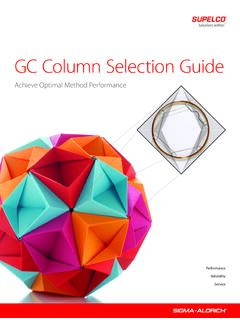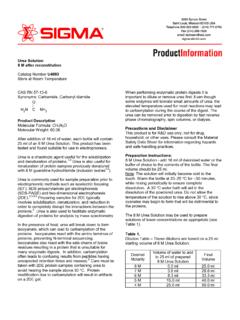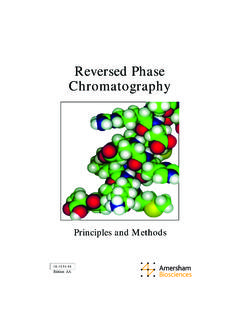Transcription of Guide to Solid Phase Extraction - Sigma-Aldrich
1 Bulletin 910T197910 1998 Sigma-Aldrich Phase Extraction (SPE) is an increasingly useful sample preparation technique. With SPE, many of the problems associated withliquid/liquid Extraction can be prevented, such as incomplete Phase separations, less-than-quantitative recoveries, use of expensive,breakable specialty glassware, and disposal of large quantities of organic solvents. SPE is more efficient than liquid/liquid Extraction ,yields quantitative extractions that are easy to perform, is rapid, and can be automated. Solvent use and lab time are is used most often to prepare liquid samples and extract semivolatile or nonvolatile analytes, but also can be used with solidsthat are pre-extracted into solvents. SPE products are excellent for sample Extraction , concentration, and cleanup.
2 They are availablein a wide variety of chemistries, adsorbents, and sizes. Selecting the most suitable product for each application and sample is Types2 Reversed Phase packingsNormal Phase packingsIon exchange packingsAdsorption packingsSPE Theory3 How compounds areretained by the sorbentReversed Phase SPEN ormal Phase SPEIon exchange SPES econdary interactionsThe role of pH in SPEHow to Use SPE6 Selecting the properextraction schemeThe five-step SPE methoddevelopment processSample pretreatment options- Liquid samples- Solid samplesSPE hardware and accessoriesfor processing samples9960028 Guide to Solid Phase Extraction9950124997031299402569960029 SUPELCOB ulletin 9102sSPE tubes that are packed with this material contain stainless steel or Teflon frits.
3 Required by US Environmental Protection Agency Contract LaboratoryProgram (CLP) pesticide crosslinked, neutral, specially cleaned styrene-divinylbenzene resin. Very high surface area, mean pore size 110-175 .Silica-Based Packing 40 m particles, 60 pores (unless otherwise noted).LC-18octadecyl bonded,For reversed Phase Extraction of nonpolar to moderately polar compounds, such asendcapped silicaantibiotics, barbiturates, benzodiazepines, caffeine, drugs, dyes, essential oils,fat soluble vitamins, fungicides, herbicides, pesticides, hydrocarbons, parabens, phenols,phthalate esters, steroids, surfactants, theophylline, and water soluble bonded,Higher Phase coverage and carbon content than LC-18, greater resistance to extreme pHendcapped silicaconditions, and slightly higher capacity for nonpolar compounds.
4 For reversed phaseextraction of nonpolar to moderately polar compounds, such as antibiotics, caffeine, drugs,dyes, essential oils, fat soluble vitamins, fungicides, herbicides, pesticides, PNAs,hydrocarbons, parabens, phenols, phthalate esters, steroids, surfactants, water solublevitamins. Also available in disk bonded,For reversed Phase Extraction of nonpolar to moderately polar compounds, such asendcapped silicaantibiotics, barbiturates, benzodiazepines, caffeine, drugs, dyes, essential oils,fat soluble vitamins, fungicides, herbicides, pesticides, hydrocarbons, parabens, phenols,phthalate esters, steroids, surfactants, theophylline, and water soluble vitamins. Alsoavailable in disk bonded,Higher Phase coverage and carbon content than LC-8, greater resistance to extreme pHendcapped silicaconditions, and slightly higher capacity for nonpolar compounds.
5 For reversed phaseextraction of barbiturates, benzodiazepines, caffeine, drugs, dyes, essential oils,fat soluble vitamins, fungicides, herbicides, pesticides, PNAs, hydrocarbons, parabens,phenols, phthalate esters, steroids, surfactants, theophylline, water soluble bonded, end- Less hydrophobic than LC-8 or LC-18. For Extraction of peptides and silica (500 pores)LC-Phphenyl bonded silicaSlightly less retention than LC-18 or LC-8 material. For reversed Phase Extraction ofnonpolar to moderately polar compounds, especially aromatic surfaceFor exclusion of proteins in biological samples; retains small molecules such as drugsenclaved by aunder reversed Phase networkLC-CNcyanopropyl bonded,For reversed Phase Extraction of moderately polar compounds, normal Phase extractionendcapped silicaof polar compounds, such as aflatoxins, antibiotics, dyes, herbicides, pesticides,phenols, steroids.
6 Weak cation exchange for carbohydrates and cationic bonded silicaFor normal Phase Extraction of polar bonded silicaFor normal Phase Extraction of polar compounds, weak anion exchange forcarbohydrates, weak anions, and organic amine bondedFor strong anion exchange for anions, organic acids, nucleic acids, nucleotides, andsilica with Cl- counterionsurfactants. Capacity: acid bonded silicaFor strong cation exchange for cations, antibiotics, drugs, organic bases, amino acids,with Na+ counterioncatecholamines, herbicides, nucleic acid bases, nucleosides, and : acidFor weak cation exchange of cations, amines, antibiotics, drugs, amino acids,bonded silica withcatecholamines, nucleic acid bases, nucleosides, and + counterionLC-Sisilica gel with noFor Extraction of polar compounds, such as alcohols, aldehydes, amines, drugs, dyes,bonded phaseherbicides, pesticides, ketones, nitro compounds, organic acids, phenols, and Packing Crystalline, chromatographic grade alumina, irregular particles, 60/325 pH ~5 For anion exchange and adsorption Extraction of polar compounds, such as pH ~ adsorption Extraction of polar compounds, and cation pH ~ adsorption Extraction of polar compounds.
7 With pH adjustment, cation oranion exchange. For Extraction of vitamins, antibiotics, essential oils, enzymes,glycosides, and -Based Packing Magnesium silicate, 100/120 mesh adsorption Extraction of polar compounds, such as alcohols, aldehydes, amines,drugs, dyes, herbicides, pesticides, PCBs, ketones, nitro compounds, organic acids,phenols, and adsorption Extraction of polar compounds, such as alcohols, aldehydes, amines,drugs, dyes, herbicides, pesticides, PCBs, ketones, nitro compounds, organic acids,phenols, and Carbon-Based Packing Nonbonded carbon , surface areaFor adsorption Extraction of polar and nonpolar , 120/400 meshENVI-Carb Cnonporous, surfaceFor adsorption Extraction of polar and nonpolar 10m2/g, 80/100 meshResin-Based Packing 80-160 m spherical PssFor Extraction of polar aromatic compounds such as phenols from aqueoussamples.
8 Also for adsorption Extraction of nonpolar to midpolar aromatic Phase TypesAdsorptionIon ExchangeReversed PhaseNormal Phase3 SUPELCOB ulletin 910 SPE TheoryHow Compounds Are Retainedby the SorbentReversed Phase (polar liquid Phase , nonpolar modified Solid Phase )Hydrophobic interactionslnonpolar-nonpolar interactionslvan der Waals or dispersion forcesNormal Phase (nonpolar liquid Phase , polar modified Solid Phase )Hydrophilic interactionslpolar-polar interactionslhydrogen bondinglpi-pi interactionsldipole-dipole interactionsldipole-induced dipole interactionsIon ExchangeElectrostatic attraction of charged group on compoundto a charged group on the sorbent s surfaceAdsorption(interactions of compounds withunmodified materials)Hydrophobic and hydrophilic interactions may applyDepends on which Solid Phase is usedReversed Phase SPER eversed Phase separations involve a polar (usually aqueous;see Table A on page 8) or moderately polar sample matrix (mobilephase) and a nonpolar stationary Phase .
9 The analyte of interestis typically mid- to nonpolar. Several SPE materials, such as thealkyl- or aryl-bonded silicas (LC-18, ENVI-18, LC-8, ENVI-8,LC-4, and LC-Ph) are in the reversed Phase category. Here, thehydrophilic silanol groups at the surface of the raw silica packing(typically 60 pore size, 40 m particle size) have been chemicallymodified with hydrophobic alkyl or aryl functional groups byreaction with the corresponding Si-OH + Cl-Si-C18H37 Si-O-Si-C18H37 + HClCH3CH3 Retention of organic analytes from polar solutions ( water)onto these SPE materials is due primarily to the attractive forcesbetween the carbon-hydrogen bonds in the analyte and thefunctional groups on the silica surface.
10 These nonpolar-nonpolarattractive forces are commonly called van der Waals forces, ordispersion forces. To elute an adsorbed compound from a re-versed Phase SPE tube or disk, use a nonpolar solvent to disruptthe forces that bind the compound to the packing. LC-18 andLC-8 are standard, monomerically bonded silicas. Polymericallybonded materials, such as ENVI-18 and ENVI-8, result in a morecomplete coverage of the silica surface and higher carbon load-ing. Polymeric bonding is more resistant to pH extremes, and thusis more suitable for environmental applications for trapping or-ganic compounds from acidified aqueous samples. All silica-based bonded phases have some percentage of residual unreactedsilanols that act as secondary interaction sites.













